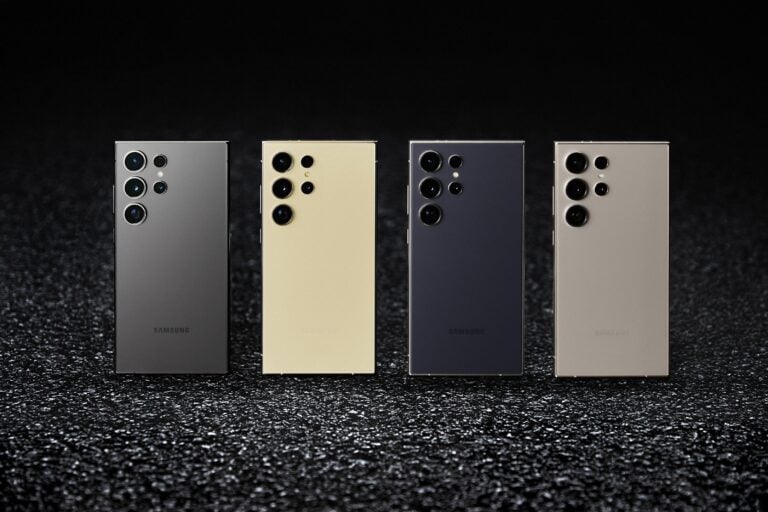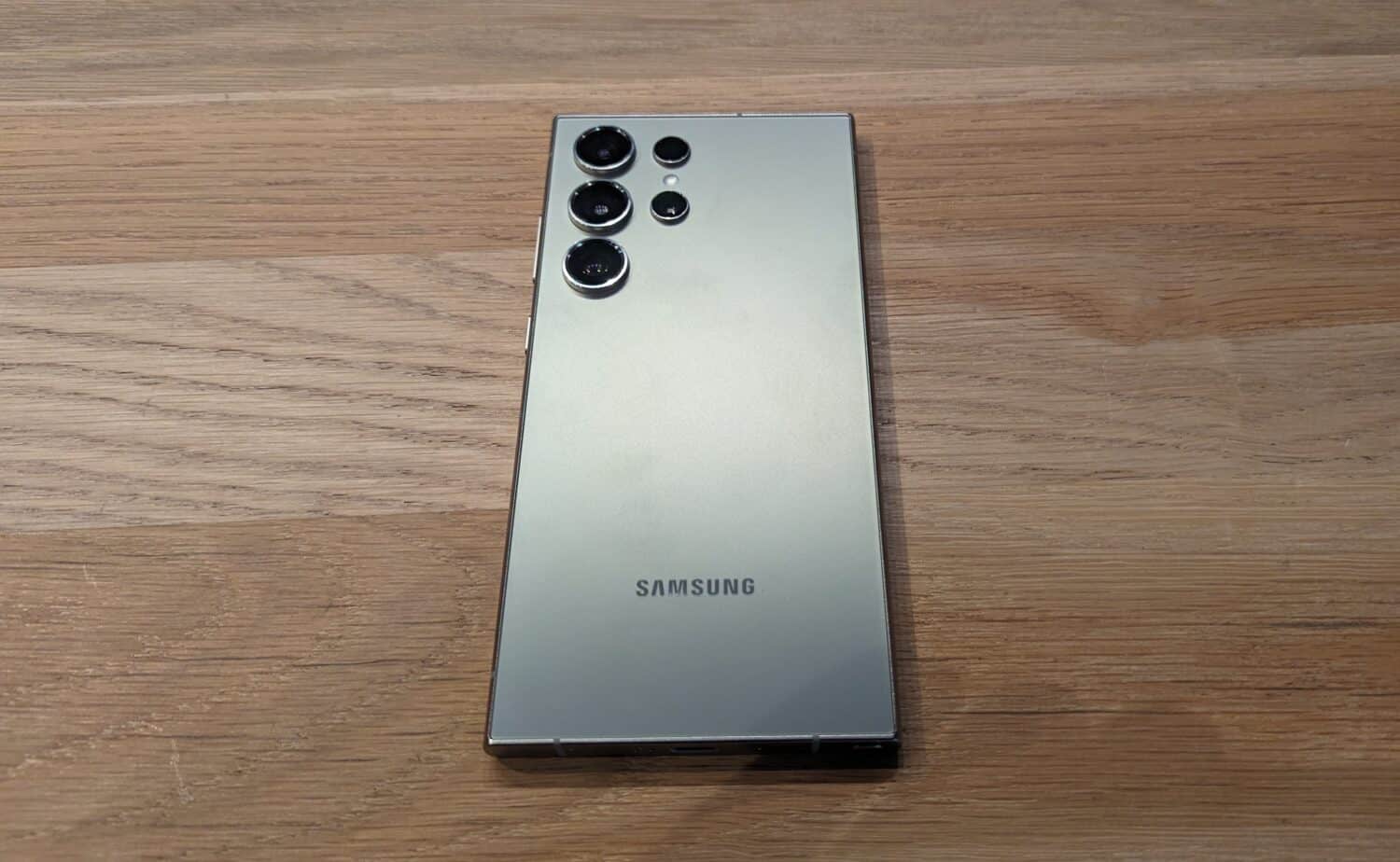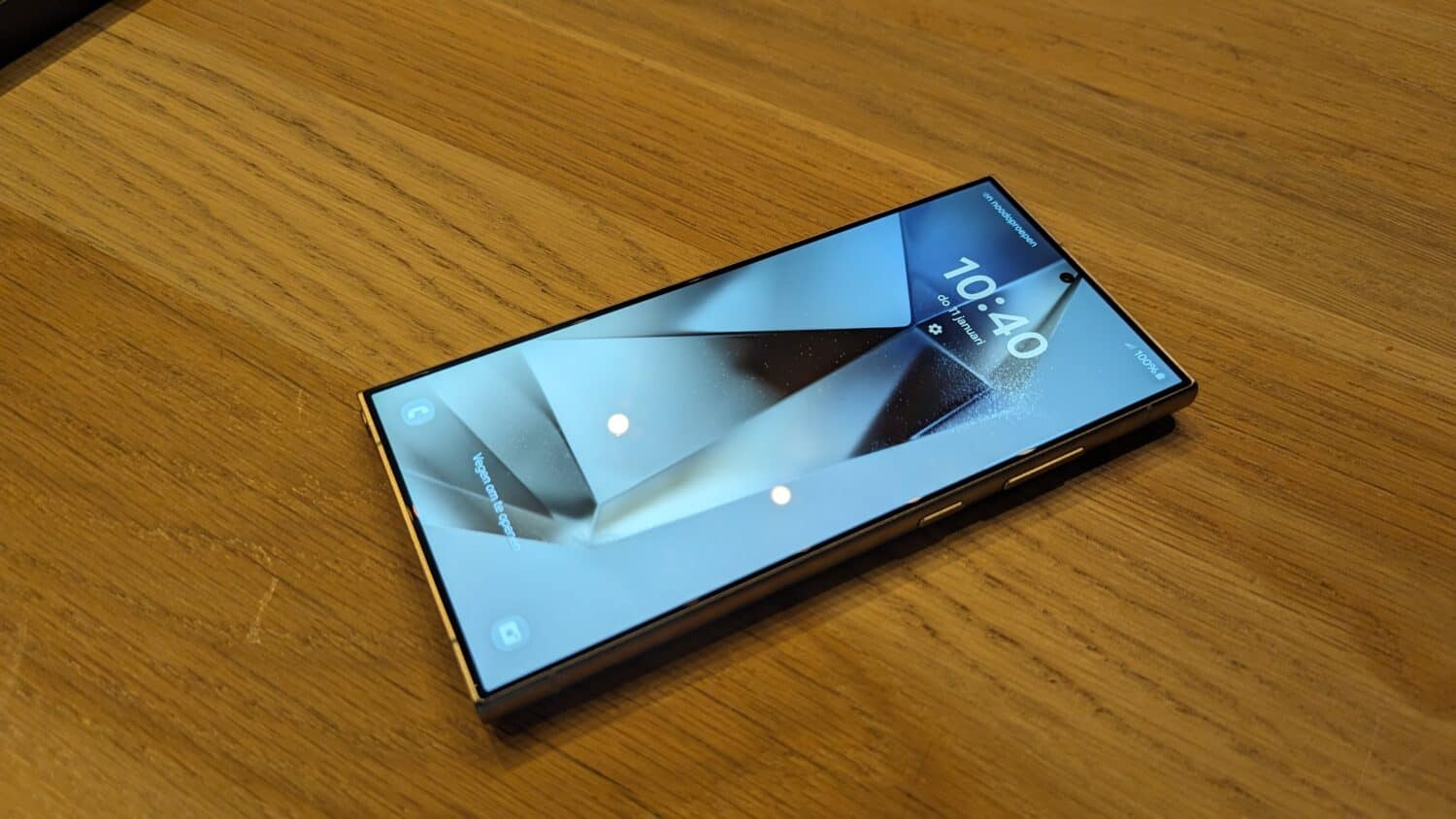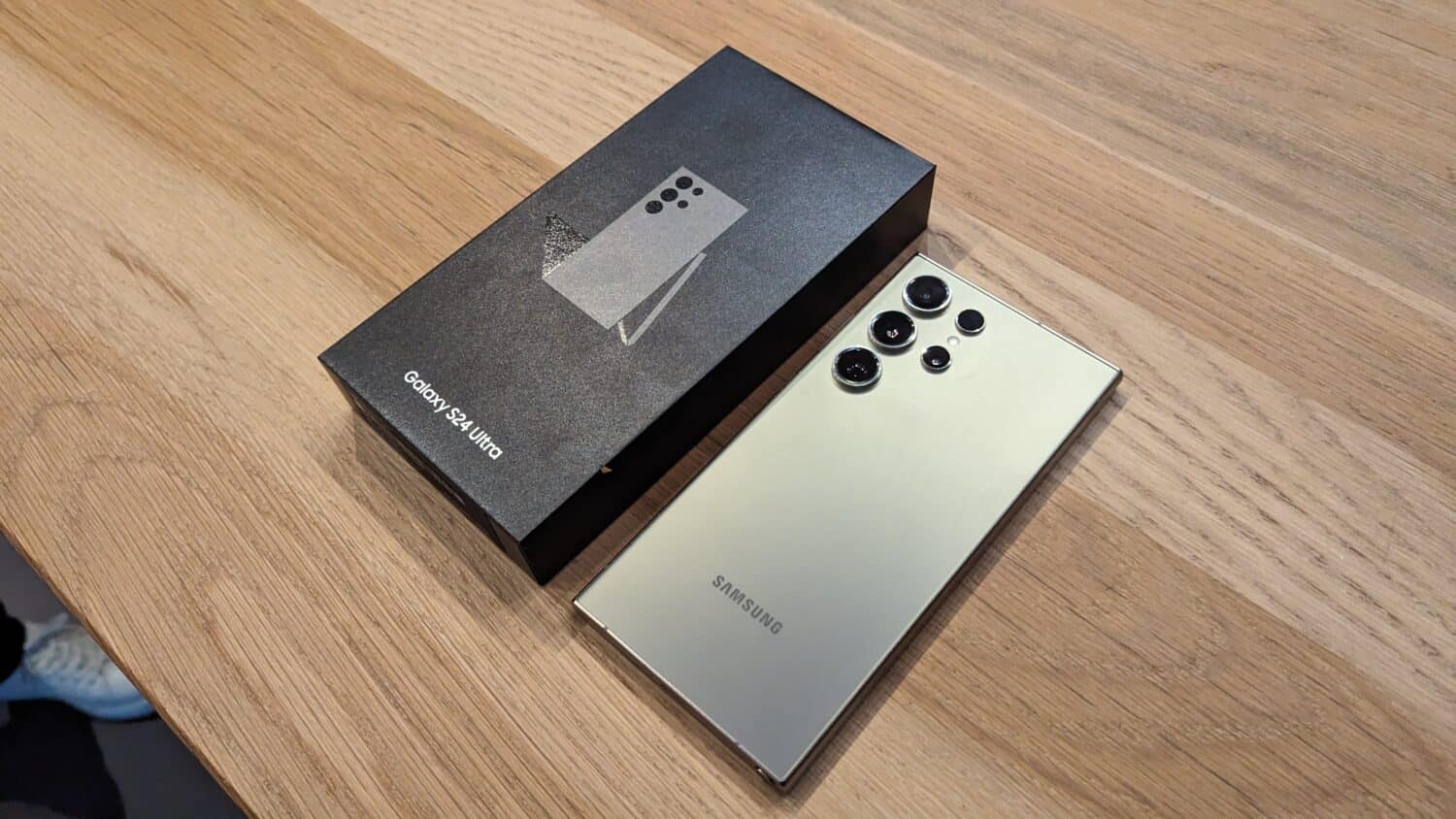Samsung has put the moniker “Galaxy AI” front and center in bringing its S24 series to market. The company promises users increased productivity by making advanced capabilities available at your fingertips. As usual, the Ultra is the top-of-the-line model, which we put to the test for a fortnight. Do the AI features deliver as promised? And is there perhaps more going on beyond AI to opt for the latesr Samsung flagship?
The first notable innovation compared to the S23 Ultra is immediately apparent. Samsung has once again opted for a new type of glass on top off its display: Gorilla Glass Armor. In addition to offering greater scratch resistance, the company promises 70 percent less reflectivity. In practical terms, this means near-ubiquitously visible screen, even when faced with the bright outdoors. It makes the device more universally useful, a benefit that you’ll notice time and again.
Another exterior difference with the S24 Ultra is that the screen is no longer curved on its sides. Samsung has chosen for said curved style in premium models for years, but it is now moving away from it. In effect, the company is joining a broader smartphone trend that leads to a kind of uniformity not everyone will be pleased with. In addition, Samsung is following the material choice Apple made for the iPhone 15 by using titanium. However, Samsung uses a significantly lesser amount of the stuff, and a cheaper version to boot (it’s Grade 2 versus Grade 5 at Apple). In addition, teardowns show that this metal is mostly eye candy: the frame is largely made of plain-old plastic.
We will return to the silicon inside later in this review, but it is immediately noticeable that the Ultra is still blazing fast. By now, premium phones have reached a performance level where specs barely feature in conversations around new releases. Still, you notice the grunt on offer when launching any app, multitasking and running heavy workloads – there’s more than enough processing power at the ready. The phone churns through it all with ease, with app scrolling being a straightforward example that highlights how this can impact the user experience. Whereas a phone like the Google Pixel 7 soon needs a breather when it’s loading new videos from a YouTube feed, the S24 Ultra keeps going for longer without any sign of interruption. More often than not, the limiting factor will seemingly be the software, not the hardware.
Knowns and unknowns
Other specifications of the S24 Ultra match its vaunted predecessor. The 120Hz AMOLED display is brighter than ever and still offers a maximum resolution of 3088×1440. However, at the time of writing, the Vivid colour pallette is essentially the same as the Normal one. Given Samsung has featured eye-popping vibrancy before, this will irk some. Thankfully, an update is already on its way, but too late to feature in this review. The S-Pen returns, including the ability to write a quick note without having to unlock the device.
As before, the phone starts up asking you to sign in with a Samsung Account. A sign-in is necessary to take advantage of Galaxy AI, which runs largely on the cloud. Samsung lists a wide variety of features under the heading of “Advanced Intelligence” inside the settings menu. Perhaps that’s also a better name for this feature set than Galaxy AI, if we’re being honest: all sorts of capabilities, from live transcriptions to text summaries to photo editing, fall under it. They’re not all GenAI or even entirely new, but aim to offer an additional layer of sophistication to make life easier.
Let’s start with something that premium smartphones have deployed as an essential selling point for years: the camera. Only one hardware change has been made on this front: the 10x optical zoom has given way to a 5x sensor. While that may sound like a downgrade, it’s quite a smart choice. Previously, the 3x camera was used for everything between 3x and 10x zooms, while the 10x lens was only usable when trying to shoot something in the distance. Now the camera app can switch over to 5x zoom, resulting in sharper photos at medium distances. Given that’s generally a more common distance for photo subjects, the cameras feel more effective than before. Below is an overview of the different zoom levels (1x, 2x, 3x, 5x, 10x – click to zoom in):





At the 10x zoom, AI upscaling ensures that the final result from a digital zoom is barely inferior to an optical one. In most cases, the images continue to impress even at such distances. In other words, the cameras are still great.
Galaxy AI: photos, videos, Circle to Search
Only in photo editing does the AI story start to capture the imagination more. If your picture is slightly askew, AI can help out by correcting it and filling in the extra space. People and objects in images can also be repositioned after the fact, after which Galaxy AI fills in the cropped region. Samsung calls this “Generative Edit.” One shouldn’t expect miracles here. For example, the generator seems to really like tables and plants as stand-ins in an image. This is really a bit of a gimmick anyway, as you can’t actually control it. Once AI photo editing can follow explicit suggestions, it will be a compelling feature. With an ideal AI application, you’d ask a chatbot inside the Gallery app to make a specific edit and it will try to comply. We’re not there yet.
From now on, it’s also possible to shoot 4K images at 120fps. To some, that may even sound a little excessive and does lead to some huge file sizes, but it plays well into another AI feature. Namely, Instant Slowmo, which allows even this type of footage to be slowed down dynamically – it means you no longer have to explicitly select the slow-motion option. Interpolation generates frames between existing ones, with generally acceptable results. AI does tend to create a “ghosting” effect: for example, if an arm moves quickly through the image, a skin-toned smudge follows in its wake. Again, there’s room for improvement here, but the feature is at least usable.
Another prominent feature is found throughout the operating system. Circle to Search, which Samsung adopted from Android maker Google, allows you to search for any object in any app on the Internet. This is basically Google Lens, which already exists as a separate app. The big difference is that the tool can be used for anything that might appear on the screen, whether that’s the Netflix app or a news site. It works on an OS level, meaning no publisher can block it. Combined with the S-Pen, it is pretty intuitive. For some users, this will be a godsend, as the Google Lens search function can be very accurate. On the other hand, there are misses, and you cannot search for specific people due to privacy concerns.
Text and sound
Users of the Samsung browser can now use a new AI tool to summarize whatever’s on a webpage. At least, that’s the idea. On our own website, it didn’t work for half the time. The notification suggested that the page might contain malicious content, although we understand from Samsung that some webpage layouts simply don’t play nicely with the feature. As a result, it only works inconsistently. The quality of the generated summaries also varies wildly. At times, the feature picks up on nearly all relevant details, but on occasion, it’ll present five quite meaningless points. Your mileage may vary.
For shorter notes, though, this summarization works a lot better. Likewise, you can have AI clean up a somewhat disorganized piece of text in the Notes app. The AI functionality usually draws the right conclusions and regularly comes up with clever groupings, such as the type of products in a shopping list or a creative subtitle of a paragraph.
The volatility does continue, however, as shown by the remaining prominent AI features: Live Translate and Chat Assist. For us, the first functionality cannot be meaningfully tested. After all, our native tongue (Dutch) is not yet supported – that should change in the coming months. Chat Assist does work with the Dutch language and can suggest alternative versions of draft messages. Examples include a neater or more informal wording to suit a particular situation or conversation partner. This does eventually raise the question: who consistently writes this in the wrong tone and has Samsung constantly adjust it? It seems like it’ll be useful a few times, but may provide a sense of inauthenticity when used consistently.
However, the ability to translate any chat message across every app is a great addition. Deep learning translations are rarely perfect, even with the best tools. However, for everyday communication with someone in another language, you won’t have to step out of a particular app from now on, as Samsung has baked in the translation capability on the virtual keyboard. It also remembers which chats feature a particular language if needed.
The last software feature we’ll discuss that’s sometimes associated with AI (but not always) is speech-to-text in the Recorder app. Samsung’s functionality is highly reminiscent of the existing Recorder app that Google puts in its Pixel phones, but the former undercuts it. Although Google struggles with some other languages, it excels in English. Samsung’s solution is less accurate, so perhaps some more borrowing from Google would leave all involved better off.
Availability remains a question mark
Regardless, we should note two aspects of Galaxy AI, both of which relate to availability. First, previous Galaxy devices and tablets will also receive some of the aforementioned AI features, which may essentially remove a significant rationale for choosing the S24 series. Second, Samsung has only promised to keep Galaxy AI free until the end of 2025. The reason is pretty obvious: AI is expensive to run, and most of Galaxy AI isn’t on-device. We can’t be sure of what will happen after this guaranteed-to-be-free period is over. This offers little guidance for users who may be basing their purchase on these new features. Samsung could have seen this coming from miles away, so it is a mystery why it hasn’t provided any clarity.
Common use
What is striking is that all the AI capabilities mentioned are quite easy to simply forget about if they don’t appeal. After all, they require a certain change in behaviour. If you go along with that, the various features won’t always meet you halfway. We should not confuse the enormous potential of AI with some suboptimal applications that need more work. Unfortunately, quite a few more updates will be needed before Galaxy AI becomes an unmissable option. Despite spending much of this review on these features, the usual elements of a phone are at least as relevant. Indeed, the S24 Ultra is excellent on other fronts, something that may be enough reason to choose this device.
For example, seven-year OS support is an outstanding addition. Once infamous for the short-lived support it offered its Galaxy phones, Samsung is now almost at the forefront of it. Unlike the 10 years promised by Fairphone with the Fairphone 5, users here can count on hardware that is currently state-of-the-art and uncompromised. That means the S24 Ultra will, in all likelihood, still be a capable enough device for years to come.
After prolonged use, for example, the battery proves robust. Despite being equipped with the same 5000 mAh as before, we end each day with higher battery percentages. In this area, there seemed little room for improvement, but nothing could be further from the truth. Screen-on time sits between 8 and 12 hours, depending on the type of applications running. However, the S24 Ultra can get particularly hot in some specific scenarios, particularly if you are shooting photos/videos for a longer period of time or running intensive benchmarks. The former is a situation many users will find themselves in, the latter not so much.
Said benchmarks show significantly improved performance. As usual, Samsung opts for the latest Snapdragon with the Gen 3, which again has received its annual “for-Galaxy” tweaks. All this is greatly helped by the fact that even the cheapest Ultra now includes 12GB of system memory. It’s a welcome change. Below is an overview of Geekbench 6 figures comparing the S24 Ultra to its predecessor:
| Samsung Galaxy S23 Ultra (12GB RAM) | Samsung Galaxy S24 Ultra (12GB RAM) | |
| CPU (single-core) | 1886 | 2301 |
| CPU (multi-core) | 5000 | 7238 |
| GPU (OpenCL) | 8813 | 15120 |
| GPU (Vulkan) | 5976 | 17030 |
In short: we can spot a CPU performance improvement of either 22 percent (single-core) or 44 percent (multi-core), while the GPU within the updated Snapdragon is 71 percent faster (OpenCL) or even triples its score in the Vulkan renderer. All this shows that, beyond Galaxy AI, there has been a tremendous amount of work behind the scenes to make the S24 Ultra a reality, albeit that Qualcomm developed the SoC itself and is largely to thank for it. For consumers, that doesn’t matter: the numbers don’t lie, and the S24 Ultra is stunningly fast.
Conclusion
In conclusion, few phones come close to the Galaxy S24 Ultra in terms of hardware. The SoC, screen, cameras, 12GB of RAM and titanium chassis combine to form an impressive device. In terms of software, the story is a bit more complex. Indeed, the potential of Galaxy AI is great, but a lack of full support for many other languages and overly variable end results paint a somewhat divisive picture. Rather, it seems that this is a slightly early peek at what’s possible with some features, while Samsung could potentially turn to Google to enhance transcriptions, for example. And since we cannot currently guarantee that all of this will remain free, we are not inclined to call Galaxy AI a resounding success just yet. Such features sit atop a deeply impressive hardware package, at least.
Samsung will continue to tinker with the software, presumably with increasingly impressive results that will also benefit users of the S23 series. Those who prefer to buy the latest device, however, will get seven years of OS support, better specifications and arguably a more premium look.
The Ultra has been given MSRPs of 1449 euros (256GB), 1569 euros (512GB) and 1809 euros (1TB). This is at least 50 euros higher than the S23 Ultra was, albeit with better specs. Last year’s model is still a very capable device, but if you spread the extra cost over a 24-month contract term, you’d probably want to opt for the latest and greatest.
Also read: Samsung update brings Galaxy AI features to more devices



